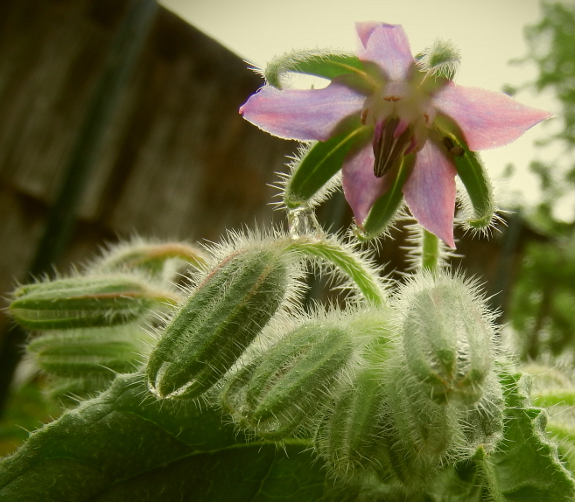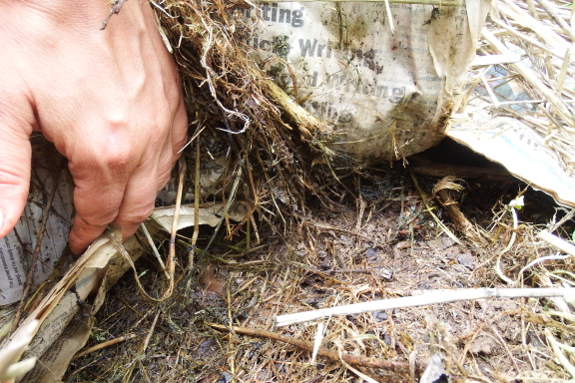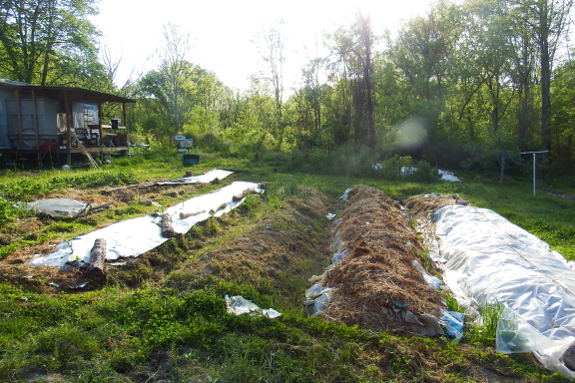
Worm test in solarized soil

It's time for another
update on this year's mulch experiments! And, since I know many of you
only drop by for the photos and will be disappointed by what follows,
here's a pretty borage flower to start your day off right.

Okay, back to the point. A couple of weeks ago, I posted about several quick no-till garden prep options I'm trying out this year (shown below in a photo taken in the mid May). The time came to plant into the first round of beds this week --- one that was solarized
and then covered with goat bedding for two weeks, one that was
solarized and then left bare for two weeks, and one that was treated to a
kill mulch of newspaper topped with goat bedding. All had received
their initial treatment at about the same time, around six weeks ago.
 I
have a bias against solarization, so I was prepared to be annoyed by
those beds. However, the bed that was solarized and then immediately
treated with a topdressing of goat manure/straw was home to the most
worms of all treatments. Second best was the kill mulched bed,
suggesting that the manurey bedding was what attracted the worms in both
cases. Presumably the newspaper barrier in the kill mulched bed slowed
down the worm-attracting powers of the manure, although the paper did
make that bed ultra-easy to prepare for planting since there were no
weeds present after only a few weeks of kill mulching.
I
have a bias against solarization, so I was prepared to be annoyed by
those beds. However, the bed that was solarized and then immediately
treated with a topdressing of goat manure/straw was home to the most
worms of all treatments. Second best was the kill mulched bed,
suggesting that the manurey bedding was what attracted the worms in both
cases. Presumably the newspaper barrier in the kill mulched bed slowed
down the worm-attracting powers of the manure, although the paper did
make that bed ultra-easy to prepare for planting since there were no
weeds present after only a few weeks of kill mulching.
After digging in the dirt, my least favorite bed was the one that had been solarized and then left bare. My goal there was to keep the nitrogen levels in that bed to a minimum so my green beans wouldn't attract as many bad bugs,
but the short-term result was that a lot of warm-season grasses
sprouted under the heating effects of the solarization and I had to do a
lot of handweeding before planting. Worms were also absent from the top
few inches of that bed. So I think that these quick fixes really should
be paired with a yummy source of organic matter like compost or manure
if you want to keep your microorganisms happy.
I've got more to tell you
about experimental mulches, but this post got too long. So stay tuned
for another round of information tomorrow!
Want more in-depth information? Browse through our books.
Or explore more posts by date or by subject.
About us: Anna Hess and Mark Hamilton spent over a decade living self-sufficiently in the mountains of Virginia before moving north to start over from scratch in the foothills of Ohio. They've experimented with permaculture, no-till gardening, trailersteading, home-based microbusinesses and much more, writing about their adventures in both blogs and books.
Want to be notified when new comments are posted on this page? Click on the RSS button after you add a comment to subscribe to the comment feed, or simply check the box beside "email replies to me" while writing your comment.
